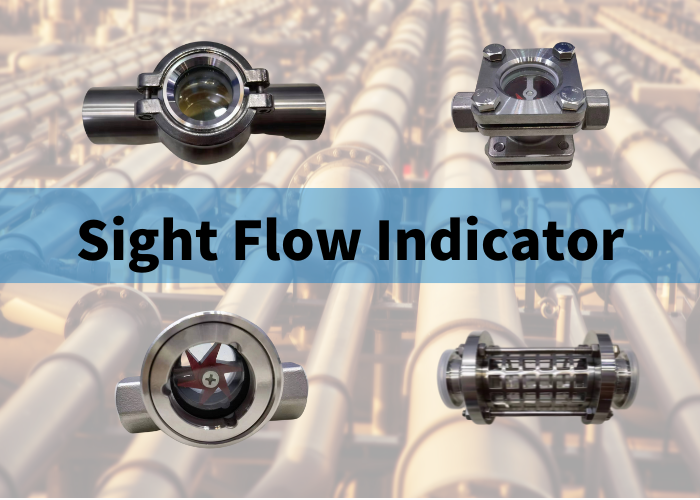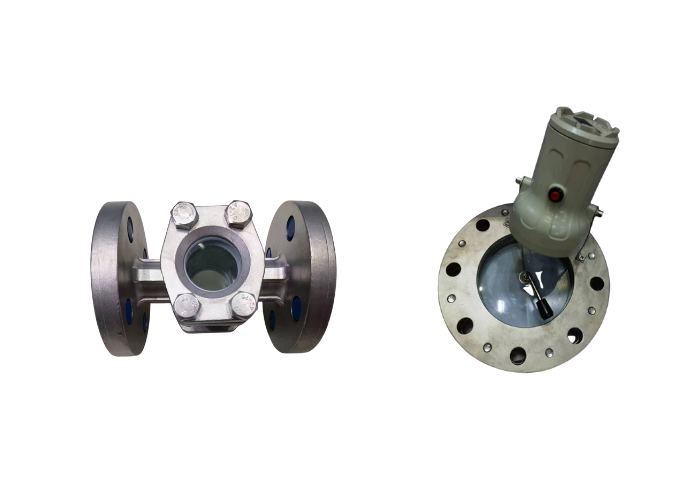
I. Introduction
Visual observation is crucial in industrial processes, allowing operators and maintenance personnel to visually inspect and monitor fluid flows, levels, and process conditions. It enables early detection of issues, timely intervention, and optimization of processes for improved efficiency and safety.
Flange sight glass is a specialized component for visual inspection in industrial applications. It consists of a transparent glass window housed within a flanged assembly that can be integrated into pipelines, tanks, or vessels. The design ensures a secure and leak-proof installation while providing a clear view of the fluid or process inside.
This blog aims to delve into the advantages and applications of flange sight glass in various industries. By understanding the benefits and specific uses of flange sight glass, readers will gain insights into how this tool can enhance visual observation, improve safety, optimize processes, and ensure product quality in different industrial sectors.
II. Advantages of Flanged Sight Glass
Enhanced Visibility and Real-Time Monitoring Capabilities:
Flange sight glass offers a clear and unobstructed view of fluids or processes, enabling operators to visually observe parameters such as fluid levels, flow rates, color, and clarity in real-time. This enhanced visibility allows for better monitoring, detection of abnormalities, and timely decision-making.
Improved Safety and Risk Mitigation:
Flange sight glass contributes to improved safety in industrial processes. Operators can visually confirm the absence of leaks, blockages, or hazardous conditions, ensuring a safer working environment. Early detection of potential risks through visual observation helps prevent accidents, equipment failures, and process disruptions.
Process Optimization and Efficiency Gains:
By providing real-time visual feedback, flange sight glass allows process optimization and efficiency gains. Based on the observed conditions, operators can monitor and adjust parameters, such as flow rates or mixing efficiency. This leads to improved process control, reduced waste, and enhanced productivity.
Facilitation of Maintenance and Troubleshooting Activities:
Flange sight glass simplifies maintenance and troubleshooting tasks. Operators can visually inspect equipment internals, detect any anomalies or mechanical failures, and identify the root causes of issues. This facilitates prompt maintenance actions, minimizes downtime, and ensures efficient system operation.
Quality Control and Assurance:
Flange sight glass plays a crucial role in quality control and assurance. Operators can visually assess the appearance, characteristics, and integrity of fluids or products, ensuring compliance with desired specifications. The ability to detect any impurities, contaminants, or defects in real time enables proactive measures to maintain consistent product quality.
III. Applications of Flanged Sight Glass in Different Industries
A. Oil and Gas Industry:
§ Fluid Level Monitoring in Storage Tanks and Pipelines:
Flange sight glass is extensively used in the oil and gas industry to monitor fluid levels in storage tanks and pipelines. By providing a clear view of the fluid inside, operators can accurately assess inventory levels, prevent overflows or shortages, and optimize logistical operations.
§ Observation of Process Flow in Refineries:
In refineries, flange sight glass allows operators to observe fluids flow through various refining process stages. This visual monitoring helps identify any blockages, leaks, or irregularities in the flow, enabling timely interventions to maintain process efficiency and prevent equipment damage.
B. Chemical Industry
§ Visual Inspection of Chemical Reactions and Mixing Processes:
Flange sight glass finds extensive application in the chemical industry for visual inspection of chemical reactions and mixing processes. Operators can observe the progress of responses, monitor the mixing efficiency, and ensure proper reaction conditions. This visual feedback helps in optimizing the reaction parameters and maintaining product quality.
§ Monitoring of Filtration and Separation Processes:
Flange sight glass is utilized in the chemical industry to monitor filtration and separation processes. Operators can visually inspect the clarity of the filtrate or observe the separation of different phases, ensuring efficient and effective filtration. It helps detect any blockages or irregularities in the filtration system, allowing for timely intervention and maintenance.
C. Pharmaceutical Industry
§ Assurance of Product Quality and Compliance:
Flange sight glass ensures product quality and compliance with regulatory standards in the pharmaceutical industry. Operators can visually inspect critical processes, such as mixing, granulation, and liquid filling, to provide pharmaceutical products with proper formulation, homogeneity, and integrity. Observing these processes in real-time help maintain consistent quality and mitigate the risk of product defects or contamination.
§ Observation of Critical Manufacturing Processes:
Flange sight glass is used to observe and monitor critical manufacturing processes in the pharmaceutical industry. Operators can visually assess the behavior of fluids during various stages of drug production, including reactions, crystallization, or drying. This visual feedback allows for prompt adjustments, troubleshooting, and optimization of process parameters, ensuring efficient and reliable manufacturing operations.
D. Food and Beverage Industry
§ Monitoring of Fluid Levels in Processing and Storage Tanks:
Flange sight glass is widely used in the food and beverage industry to monitor fluid levels in processing and storage tanks. Operators can visually inspect the levels of ingredients, liquids, or products, ensuring proper inventory management, preventing overflows, and maintaining continuous production.
§ Observation of Mixing, Blending, and Filling Processes:
Flange sight glass is employed in the food and beverage industry to observe and monitor mixing, blending, and filling processes. Operators can visually assess the mixtures’ homogeneity, consistency, and quality, ensuring the desired product characteristics. This real-time observation helps maintain product standards, optimize formulations, and prevent segregation or inadequate filling.
E. Water and Wastewater Treatment
§ Flow Observation and Monitoring in Treatment Processes:
Flange sight glass is utilized in water and wastewater treatment facilities to observe and monitor the flow of fluids during various treatment processes. Operators can visually assess the flow’s velocity, turbulence, and uniformity, ensuring efficient and effective treatment. This visual feedback helps optimize process parameters and detect any flow abnormalities or disruptions.
§ Detection of Abnormalities or Contaminants in Water Systems:
Flange sight glass plays a crucial role in detecting abnormalities or contaminants in water systems. Operators can visually inspect the water’s clarity, color, and presence of suspended solids or impurities. This visual observation enables timely identification of potential issues, such as fouling, scaling, or contamination, allowing for prompt corrective actions to ensure the quality and safety of the treated water.
F. Power Generation:
§ Monitoring Fluid Flow in Steam and Coolant Systems:
Flange sight glass is utilized in power generation facilities to monitor the flow of fluids, such as steam and coolant, within various systems. Operators can visually observe the flow rates, pressure, and any irregularities in the flow, ensuring efficient heat transfer and proper operation of power generation equipment. This visual monitoring helps identify blockages, leaks, or flow disruptions, enabling timely interventions to maintain system performance.
§ Visual Inspection of Critical Equipment and Processes:
Flange sight glass allows for visual inspection of critical equipment and processes in power generation facilities. Operators can visually assess the condition, operation, and performance of components like pumps, turbines, and boilers. This observation helps detect any abnormalities, such as leaks, vibrations, or overheating, enabling proactive maintenance and minimizing downtime.

V. Considerations for Selecting Flange Sight Glass
When choosing a flange sight glass for a specific application, several factors must be considered to ensure optimal performance and compatibility with the system requirements. Here are some key considerations:
A. Operating Conditions:
§ Pressure Rating: Determine the maximum pressure the flange sight glass will be exposed to and select a suitable design to withstand that pressure without compromising safety.
§ Temperature Rating: Consider the operating temperature range and choose a flange sight glass with appropriate materials and thermal resistance to prevent damage or distortion.
B. Fluid Compatibility:
§ Chemical Compatibility: Evaluate the nature of the fluid being observed and ensure that the glass material and gasket used in the flange sight glass are resistant to the chemicals present to prevent corrosion or degradation.
§ Fluid Properties: Consider the fluid’s viscosity, acidity/alkalinity, or presence of solid particles to select the appropriate glass thickness, materials, or additional features like wipers or cleaning systems.
C. Visibility and Clarity:
§ Glass Material and Coating: Choose a transparent material, such as borosilicate or quartz, known for its clarity and resistance to thermal stress. Consider anti-reflective coatings to minimize glare and enhance visibility.
§ Lighting Options: Evaluate the lighting conditions in the installation environment and consider different lighting systems, such as LEDs or fiber-optic lights, to improve visibility if needed.
D. Installation and Maintenance:
§ Flange Compatibility: Ensure that the flange sight glass matches the flange standards and dimensions of the existing system to ensure proper installation and a leak-proof seal.
§ Maintenance Requirements: Consider ease of access for cleaning, gasket replacement, or any required maintenance procedures to minimize downtime and ensure smooth operation.
E. Customization Options:
§ Size and Shape: Determine the desired size and shape of the flange sight glass based on the available space and specific requirements of the application.
§ Additional Features: Explore customization options like magnification lenses, wipers, or cleaning systems based on the specific needs of the observation and monitoring process.
VI. Installation and Maintenance Guidelines
Proper installation and regular maintenance are essential for ensuring flange sight glass’s optimal performance and longevity. Here are some guidelines to follow:
A. Installation Guidelines:
§ Flange Preparation: Ensure the flange surface is clean, free from debris or contaminants. Check for any damage or irregularities that may affect the sealing integrity.
§ Gasket Selection: Choose the appropriate gasket material based on fluid compatibility and operating conditions. Ensure the gasket matches the flange specifications and is properly seated to provide a reliable seal.
§ Glass Handling: Handle the glass portion of the sight glass with care, using gloves if necessary, to prevent any damage or contamination. Clean the glass surface before installation to ensure clarity.
§ Bolting: Securely bolt the flange sight glass assembly to the flange using appropriate bolts and fasteners. Follow the recommended torque specifications to ensure proper sealing without over-tightening.
§ Leak Testing: Perform a leak test after installation to verify the integrity of the seal. Apply appropriate pressure or perform a visual inspection to ensure no leaks are present.
B. Maintenance Guidelines:
§ Regular Cleaning: Clean the glass surface regularly using a suitable cleaning agent or solution recommended for the specific application. Avoid abrasive materials that may scratch or damage the glass.
§ Gasket Inspection: Periodically inspect the gasket for wear, damage, or degradation. Replace the gasket if necessary to maintain a reliable seal.
§ Glass Inspection: Regularly inspect the glass for any cracks, scratches, or other damage that may affect visibility. Replace the glass if any defects are found.
§ Wiper and Cleaning Systems: If equipped with wipers or cleaning systems, ensure they function correctly. Clean or replace the wiper blades or cleaning mechanisms as needed to ensure clear visibility.
§ Overall System Inspection: Periodically inspect the entire flange sight glass assembly, including bolts, flange connections, and any additional features. Tighten bolts if necessary and check for any signs of corrosion or deterioration.
§ Record Keeping: Maintain a record of installation dates, maintenance activities, and any issues or observations made during inspections. This record will help track the history of the flange sight glass and aid in future maintenance and troubleshooting.






